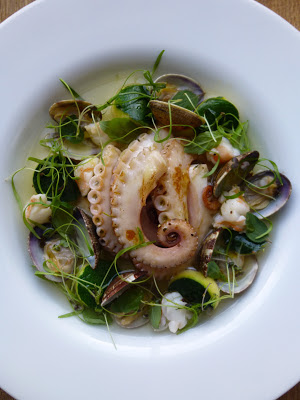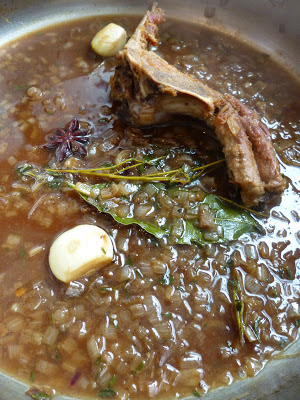This blog entry is more like Sam Eats Food, and a pop-up review instead of an actual restaurant. But a very interesting experience it was.
I always get a bit lost in Islington. It’s too easy to think of the largely middle of the road restaurants that squash between the estate agents and overpriced miscellany shops of Upper Street and feel uninspired. But if you take a walk into the network of streets around Barnsbury and Canonbury there are some little gems to be found. The most recent discovery was this weekend, when I was guided down a quiet dark backroad into a fairly demolished shell of a building. I had forgotten all about Feast since I bought the tickets, and with some busy weeks at work the event crept up quickly. I didn’t really know what to expect, but for some reason I had an underwhelming image of a large village hall with a couple of scattered stalls, and perhaps a tombola in the corner...
As usual I was proved very wrong indeed. Situated in the old Royal Mail building which is currently being shelled and developed, it reminded me why I love London for the little tucked away events that make you feel a million miles away from the daily hubbub and congestion. The first thing I noticed were the globes that illuminated the girders and crumbling bricks amidst the rising steam and bustle of the busy bar, performing band and rows of delicious looking food. So far, so good, and after a ten hour day without a scrap to eat, my stomach was groaning in sweet relief.
As with my earlier expectations, I also had a few concerns about pop-up events such as these. Sometimes events like this are overwhelmed in ‘trendiness’, and I was worried that my lack of facial piercing and wonky haircut would make me stand out like a sore thumb. I was also worried about the vast array of food choice. To put it bluntly, I am crap at making food decisions, and I always seem to choose the wrong thing to eat. And at normal inflated market prices, this means that there is no way back. The sight of a row of portaloos with random puddles surrounding them also stirred up those old festival memories. Don’t get me wrong, I cherish the times that I have had at Glastonbury, but the cuisine is never something I want to go back to.
Basically, all of these thoughts just went to prove my old short mindedness, and how I should really get out more. After quickly buying a bottle of the lovely Camden Hells from the efficient and quick bar, I was soon pottering around marvelling at the sheer variety of great looking food. There really was something for all moods, from comforting burgers and pastries to refreshing cerviche (from, naturally, Cerviche), dumplings and oysters. Initially I was looking forward to getting chops around a fish dog from the Hix stall, but this seemed like far too safe a choice considering what else was being cooked up. The best thing was the prices, which were refreshingly affordable. Most of the food sold was under £5, so I was really going to have a good taste of what was on offer. The proportion of stalls to customers was also well managed, and there was very little wait whether waiting at the bar or for food. Some stalls were far more popular than others though, and it must have been so painful sitting on a quiet stall whilst everyone piled in next door.
When I finally made my choices, the food in general was great. As soon as I approached The Modern Pantry’s stall, a plate of steaming pork loin with miso mash was thrust into my hand. And it was delicious. I expected the flavours to be strong and overpowering, but found a delicate and superbly balanced dish instead. That, and the truly wonderful salt caramel and tamarind truffle that I had from the same stall later on certainly provided the most interesting food of the evening. I must make a trip to their restaurant soon for more.
After another beer and a natter I was ready to sample some more, and this time I couldn’t help but go for something a little more familiar. I first encountered Yum Buns at Broadway Market a couple of years ago and have wanted another ever since. They are quite simply just the thing that you want on a cold day after a drink or two. A beautifully light steamed bun is filled with dirty tender pork belly and refreshing spring onions and cucumber before finishing with hoisin and hot sauce. A simple yet classic combination, and much lighter than it all sounds. And at £2.50 each they were a bargain.
There was only one choice for Katie, and she bolted straight for Anna Maes. As a self confessed mac and cheese connoisseur her standards were high, and unfortunately on this occasion she was left slightly disappointed. Although it tasted good, her timing was rubbish and she was given the last scrapings of a batch before a fresh and creamy one was started. As a result her mac was dry and crusty, and she was left with a feeling of what could have been. There were pieces of genius amongst the crunchy pasta however, such as the basil pesto which gave a lovely herby kick to each mouthful. Had she caught it right then I think it could have been a winner. Her second choice proved better with a Big Dog from the guys at Big Apple Hot Dog. This had all the best bits of a late night dog, but through it all you could really taste the quality of the meat and bread. At last a triumph.
A few bites of potentially the best meringues I have ever tasted from the Meringue Girls rounded off a brilliant evening, where all of my dodgy preconceptions were flattened. If Feast have more events lined up in the future then I would urge you to rush to it.


























